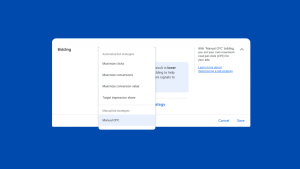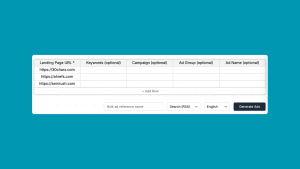Even if your Ad campaigns have been humming along generating business, an audit can always help you get a little more for your dollar.
Is your campaign not working? Even more reason to re-assess the account to see if you can start profiting off of the campaigns.
This post covers all the major parts to look at in a Google Ad account, I’ll continue to add update as the platform changes!
Table of Contents
Check Conversion Tracking (Site Tag and Goals)
What to Do:
- Verify your site tag: Ensure that your Google Ads conversion tracking tag is installed correctly on your website. This tag should fire on the appropriate pages (such as a thank you page after a purchase or form submission).
- Review your conversion goals: Check the goals you’ve set up (e.g., purchases, form completions, phone calls). Make sure they align with your business objectives.
Common Problems:
- Tag not firing: If the tag isn’t firing, you’ll miss out on conversion data. This could be due to improper installation. Check with your developer or tag manager to make sure the tag is firing.
- Wrong conversion goals: Sometimes, goals may not reflect your true business objectives or track actions that don’t matter. Make sure you’re not tracking pageviews or other low value actions as goals.
How to Fix:
- Use Google Tag Manager: This simplifies the process of managing your conversion tags across your site.
- Test your tag: Use the Google Tag Assistant Chrome extension to ensure the tag fires correctly.
- Align goals: Reevaluate your goals to ensure they track the most important actions, like sales or lead generation.
Review Campaign Structure
What to Do:
- Check campaign hierarchy: Make sure your campaigns are logically structured, with separate campaigns for different products, services, or objectives.
- Group similar keywords: Ad groups should contain tightly related keywords to ensure relevancy.
Common Problems:
- Overlapping ad groups: If multiple ad groups target the same keywords, they may compete against each other.
- Too broad: Campaigns with too many products or services in one group may lack focus.
How to Fix:
- Segment campaigns: Break up large or unfocused campaigns into more specific, manageable ones.
- Reduce overlap: Ensure each ad group is tightly focused on specific themes or products to avoid competing against yourself.
Review Campaign Settings
What to Do:
- Geographical targeting: Ensure your ads are only targeting locations where you offer services or products.
- Bidding strategy: Assess whether your bidding strategy (manual, automated, or enhanced CPC) aligns with your campaign objectives (e.g., maximizing conversions or clicks).
Common Problems:
- Wasting budget on wrong locations: Ads might be shown to users outside of your target areas, leading to wasted spend.
- Wrong bidding strategy: A mismatch between your campaign’s goals and bidding strategy could lead to poor results. Does your account have enough goal data to run a conversion bidding strategy? If not, do you have the budget to run Max clicks?
How to Fix:
- Tighten geo-targeting: Use Google Ads location settings to exclude areas where your services are not available.
- Adjust bidding strategy: If your goal is to increase conversions, if you have enough conversion data, consider switching to a smart bidding strategy like Target CPA, ROAS, or Maximize Conversions.
Review Bid Adjustments

What to Do:
- Device bid adjustments: Analyze performance across devices (desktop, mobile, tablet) and adjust bids to focus on devices that perform best.
- Location bid adjustments: Adjust bids for high-performing regions.
- Time-of-day adjustments: Review when your ads perform best (day or time) and adjust bids accordingly.
Common Problems:
- Neglecting device performance: Failing to optimize for mobile can lead to missed opportunities if a large portion of your traffic is mobile-based.
- Uneven performance across times or locations: If you’re not adjusting bids for peak times or top locations, you may miss high-conversion periods.
How to Fix:
- Use device bid modifiers: Increase bids on devices where performance is stronger.
- Dayparting: Increase bids during high-conversion hours and lower them during off-peak times.
Analyze Keywords
What to Do:
- Keyword relevance: Ensure keywords are highly relevant to your products or services. Focus on keywords with high intent.
- Performance analysis: Look at the performance of each keyword in terms of impressions, clicks, and conversions. You can filter for keywords that have high spend and high cost per conversion, decide whether you want to keep those ones.
- Keyword match types: Are your keywords serving to terms that you actually want?
Common Problems:
- Irrelevant or low-intent keywords: These drive traffic but don’t lead to conversions.
- Wasted spend on poor-performing keywords: Some keywords may be underperforming but are still eating up your budget.
How to Fix:
- Use negative keywords: Add negative keywords to filter out irrelevant traffic.
- Change broad match to exact: Turning off or changing some broad match keywords to stick to more exact terms might be helpful in reducing irrelevant terms.
- Prune poor performers: Pause or lower bids on keywords that consistently underperform.
Review Ads

What to Do:
- CTR and relevance: Review your click-through rates (CTR) for each ad to determine their effectiveness. A low CTR suggests your ads aren’t resonating with users.
- Headline performance: Test the effectiveness of headlines. Headlines should be compelling and match the search intent.
- Check ad extensions: Ad extensions make your ad visually larger and increase the likelihood of a click.
Common Problems:
- Low CTR: This could mean your ads are not relevant or engaging enough.
- Weak headlines: A weak headline can reduce click-through and conversions.
How to Fix:
- A/B test ads: Regularly test different headlines, descriptions, and CTAs to improve performance. You can pin different combinations in several RSAs to determine effectiveness, or edit a single RSA directly, replacing low impression options.
- Improve ad relevance: Ensure your ads directly address the user’s search intent and highlight the unique benefits of your offer. You can use 30characters to whip up new effective Google ads in seconds.
- Add extensions: Ad site links, callouts, structured snippets at a minimum. Logo, business name and image extensions are also recommended.
Analyze Landing Page Performance
What to Do:
- Check landing page relevance: Make sure the landing page content matches the ad message and keywords.
- Measure dwell time: Look at how long users stay on the landing page. A short dwell time may indicate that the page isn’t engaging enough.
- Track conversion rate: Your conversion rate should be in line with industry benchmarks.
Common Problems:
- High bounce rate or low dwell time: If users are leaving quickly, the page content may not be relevant or engaging.
- Low conversion rate: A low conversion rate could mean the landing page isn’t optimized for conversions.
How to Fix:
- Improve page load speed: A slow page can cause users to leave quickly. Optimize images and reduce unnecessary scripts.
- Refine CTAs: Make sure your call to action is clear and prominent. Test different versions to see which performs best.
- Ensure message match: Make sure the landing page continues the story from the ad. It should deliver exactly what the user expects. Your H1 should tell your visitors that they’re in the right place.






